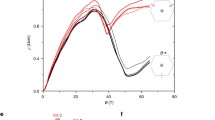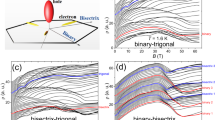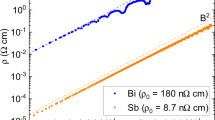Abstract
The electron and hole focusing effects in a magnetic field predicted by Pippard have been observed in bismuth. Two interlocking superconducting combs were evaporated onto the surface of a bismuth single crystal. The resistanceR(H) between the combs was measured with a superconducting voltmeter as a function of the magnetic fieldH applied parallel to the teeth of the combs. A local minimum in the resistance was observed when the magnetic field focused electrons or holes in extremal orbits between the teeth of different combs. A similar effect was observed when the combs were replaced by two parallel superconducting strips. In this case the dependence ofR(H) onH was in good qualitative agreement with the calculation of Gonçalves da Silva on a model whose Fermi surface was topologically equivalent to that of bismuth. From the values ofH at which the minima occurred we have deduced estimates forD xe andD ze , the diameters of the principal electron ellipsoid along the binary and trigonal axes. We findD xe =(0.94±0.03)×10−2 Å−1 andD ze =(1.35±0.04)×10−2 Å−1. These values lie somewhat below other values in the literature. This discrepancy may occur because each minimum inR(H) occurs at a field slightly belowH 0, whereH 0 is the field for which the diameter of the extremal electron trajectory is equal to the separation of the superconducting strips.
Similar content being viewed by others
References
F. M. Hawkins and A. B. Pippard,Proc. Camb. Phil. Soc. 61, 433 (1965).
C. Gonçalves da Silva, following paper, this issue.
M. S. Khaikin,Zh. Eksperim. i Teor. Fiz. 41, 1773 (1961) [English transl:Soviet Phys.—JETP 14, 1260 (1962)].
V. F. Gantmakher, inProgress in Low Temperature Physics, C. J. Gorter, ed. (North-Holland, Amsterdam, 1966), Vol. 5, p. 181.
A. R. Mackintosh, inPhonons and Phonon Interactions, T. A. Bak, ed. (W. A. Benjamin, New York, 1964), p. 181.
J. Clarke,Phil. Mag. 13, 115 (1966).
G. I. Rochlin,Rev. Sci. Instr. 41, 73 (1970).
M. S. Dresselhaus, inPhysics of Semimetals and Narrow-Gap Semiconductors, D. L. Carter and R. T. Bate, eds. (Pergamon, New York, 1971).
A. P. Cracknell,Adv. Phys. 18, 681 (1969).
W. S. Boyle and G. E. Smith, inProgress in Semiconductors, Vol. 7, A. F. Gibson and R. E. Burgess, eds. (Wiley, New York, 1963).
B. Lax, J. G. Mavroides, H. J. Zeiger, and R. J. Keyes,Phys. Rev. Lett. 5, 241 (1960).
R. J. Dinger and A. W. Lawson,Phys. Rev. B 7, 5215 (1973); R. Herrmann, S. Hess, and H.-U. Müller,Phys. Stat. Sol. B 48, K151 (1971).
M. H. Cohen,Phys. Rev. 121, 387 (1961).
A. P. Korolyuk,Zh. Eksperim. i Teor. Fiz. 49, 1009 (1965) [English Transl:Soviet Phys.—JETP 22, 701 (1966)].
C. Gonçalves da Silva, private communication.
R. Hartman,Phys. Rev. 181, 1070 (1969).
V. L. Newhouse, J. W. Bremer, and H. H. Edwards,Proc. IRE 48, 1395 (1960).
A. B. Pippard, J. G. Shepherd, and D. A. Tindall,Proc. Roy. Soc. (London)A324, 17 (1971).
A. F. Andreev,Zh. Eksperim. i Teor. Fiz. 46, 1823 (1964) [English transl:Soviet Phys.—JETP 19, 1228 (1964)].
J. Clarke,Phys. Rev. Lett. 28, 1363 (1972); M. Tinkham and J. Clarke,Phys. Rev. Lett. 28, 1366 (1972); M. Tinkham,Phys. Rev. B 6, 1747 (1972); J. Clarke and J. L. Paterson, to be published inJ. Low Temp. Phys.
R. N. Brown, J. G. Mavroides, and B. Lax,Phys. Rev. 129, 2055 (1963).
M. Maltz and M. S. Dresselhaus,Phys. Rev. B 2, 2877 (1970).
R. N. Bhargava,Phys. Rev. 156, 785 (1967).
I. M. Lifshitz and A. V. Pogorelov,Dokl. Akad. Nauk SSR 96, 1143 (1954).
F. M. Mueller,Phys. Rev. 148, 636 (1966).
D. H. Reneker,Phys. Rev. 115, 303 (1959).
M. S. Khaikin and V. S. Edelman,Zh. Eksperim. i Teor. Fiz. 47, 878 (1964) [English transl:Soviet Phys.—JETP 20, 587 (1965)].
R. Herrmann, S. Hess, and H.-U. Müller,Phys. Stat. Sol. B 48, K151 (1971).
Author information
Authors and Affiliations
Additional information
Work supported by the U.S. Atomic Energy Commission.
Alfred P. Sloan Foundation Fellow.
Rights and permissions
About this article
Cite this article
Clarke, J., Schwartzkopf, L.A. Magnetic focusing of electrons and holes in bismuth. J Low Temp Phys 16, 317–335 (1974). https://doi.org/10.1007/BF00655322
Received:
Issue Date:
DOI: https://doi.org/10.1007/BF00655322




